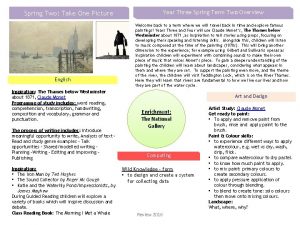Year Two Spring Term Two Overview Spring Two


- Slides: 2

Year Two Spring Term Two Overview Spring Two: Take One Picture English Inspiration: Madame André Wormser and her Children 1926/7 by Edouard Vuillard Programme of study includes: word reading, comprehension, transcription, handwriting, composition and vocabulary, grammar and punctuation. The process of writing includes: Introduce meaningful opportunity to write, Analysis of text Read and study genre examples - Talk opportunities Shared/modelled writing – Planning –Writing - Editing and improving – Publishing Inspiration: • The Bear and the Piano by David Litchfield • Jack and the Beanstalk, See The Bumper Book of Story Telling, p. 40 • Jack and the Beanstalk by Roald Dahl, Revolting Rhymes • Jack and the Beanstalk, BFI short animation During Guided Reading children will explore a variety of books which will inspire discussion and debate. Class Reading Book: Mr. Big by Ed Vere Welcome back to a term where we will travel back in time and explore famous paintings! Years One and Two will use Edouard Vuillard’s, Madame André Wormser and her Children as inspiration to tell stories using props, focusing on developing their speaking and listening skills. Alongside this, children will listen to music composed at the time of the painting (1920 s). This will bring another dimension to the experience; for example using Louis Armstrong and Bessie Smith as inspiration children will experiment with combining sounds to make their own piece of music that voices Vuillard’s piece. To gain a deeper understanding of the painting the children will learn about how portraits were/are created, considering who appears in them and which objects they choose to represent themselves. To support the painting even more, and theme of the piano, the children will read The Piano Girl which is based on a true story about a girl who loved playing the piano more than anything. Art and Design Technology Art and Design Artist Study: Edouard Vuillard Enrichment: The National Gallery Get ready to paint: • To know when to reload paintbrush. Painting & Colour Skills: • To apply pencil skills: short, long, dots, small circles, dashed, straight, curved, spirals – using a small brush. • Primary colours • Start with one colour – wash dark to light • Block one, even colour Portraits: Who, what, where and why? Review 2016

Take One Picture Mathematics Over the year, children will continue to develop their mathematical skills and knowledge through Maths Mastery. Alongside this, the children will apply their maths skills across the curriculum, for example when taking measurements in science they will develop their use of vocabulary to compare and describe measurements and apply this understanding in everyday conversations about their work. When collecting data in science, they will start to learn about statistics and interpret and construct simple charts. During geography lessons, the children will be studying the UK and learning new vocabulary to describe position and direction. Physical Education Netball and creative dance: • to develop control and coordination of their physical movements • to devise and use repeat compositions and sequences in physical activities Music Exploring sounds and beat Compose a short piece of music • to listen with concentration and understanding to a range of high-quality live and recorded music • to experiment with, create, select and combine sounds using the inter-related dimensions of music Weekly playlists played during assemblies, lunch and breaks. Music used to introduce books/art/topics. French Songs, games and rhymes – counting, animals and colours Social, Moral and Cultural Education – including Religious Education and RRS SMSC is embedded in what we do and who we are everyday. RRS: 38 Science • to use and apply simple tactics and strategies Learning Objectives: Light and Sound (additional unit) • to improve performance by observation and use criteria for evaluation Scientific Enquiry Skills Ask simple questions, and recognise that they can be answered in different ways Observe closely, using simple equipment Perform simple tests Identify and classify Use observations and ideas to suggest answers to questions Gather and record data to help in answering questions. • about the benefits of regular exercise and how their bodies feel when they exercise Review 2016 Computing Google Drive, emailing and document sharing • to use technology safely and respectfully, keeping personal information private • to identify where to go for help and support when they have concerns about content or contact on the internet or other online technologies



